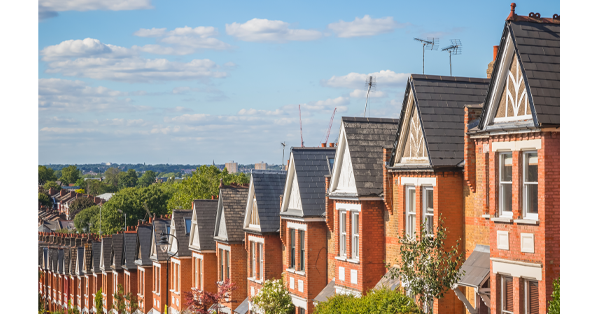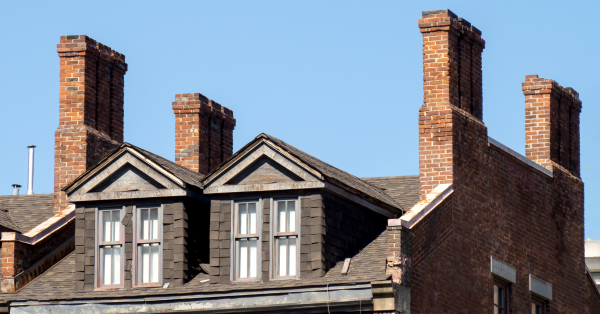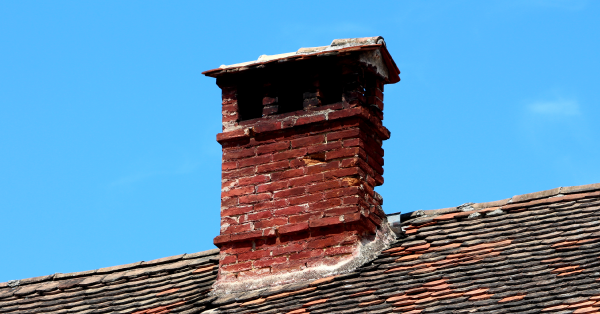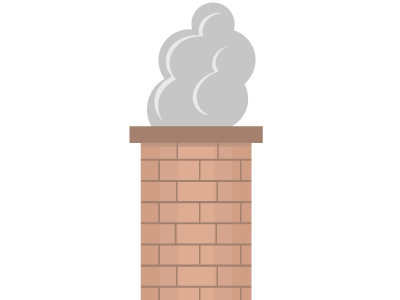Pros and Cons of 1930s Chimney Construction
- Chimneys in 1930s homes were built to last with solid brick and mortar, lined with clay or concrete to protect the brickwork.
- Top Tip: When viewing a 1930s property, pay attention to the structural soundness. Cracks in the walls, subsidence, or damp can be a clear giveaway that some issues need to be addressed.
- Maintaining a 1930s chimney can be more expensive than a modern one. You will need to budget for potential safety upgrades, mortar repointing, and regular chimney sweeps.
If you're in the market for a new home and spot a 1930s property, don't write it off as old-fashioned. For those willing to embrace a little renovation, these often-overlooked gems can be a great choice.
1930s homes blend Victorian-era style with modern design, making them perfect for combining period charm with a spacious, adaptable layout. However, it's important to consider the chimneys in these historic homes and understand how they were built and what to watch out for.
Why buy a 1930s house?
The 1930s was a golden era for British homebuilding. These homes have larger gardens, spacious rooms, and features that are hard to find in new builds many years on. They were constructed with quality materials and craftsmanship, delivering both durability and style.

Solid construction:
Built to last with bricks and mortar, homes built in this era are known for their durability and robust structure.
Character and charm:
Unique architectural details like bay windows, high ceilings, and other period features add a lot of personality.
Generous gardens:
Larger outdoor spaces compared to modern homes which offer plenty of room for gardening, entertaining, or future extensions.
Space, heat and light:
Designed to maximise natural light with larger windows.
Distinctive chimneys:
Built to last with solid brick walls. While they add character to the home as its original heating system, regular maintenance is needed to keep them safe and functional.
Get a professional surveyor to assess your 1930s home
How are old chimneys constructed?
The chimneys in 1930s houses were usually made using solid bricks and mortar and often had clay or concrete chimney liners for added protection against the corrosive impact of smoke and gases.
Brick and mortar
The primary materials builders used in 1930s chimneys were known for their strength, longevity, weather resistance, and ability to withstand high temperatures. Additionally, the brickwork adds a charming, traditional look to the home.
With long-term exposure to moisture and the elements, mortar joints can deteriorate. Repointing (repairing the mortar) could be necessary which is a costly and time-consuming process.
Repointing a chimney can set you back around £750, but this can vary depending on the size of the chimney, its location, and how long it will take to repoint. You’ll also have to factor in labour, materials, and scaffolding.

Clay or concrete chimney liners
Added inside chimney flues to protect the brickwork wall from the corrosive effects of smoke and gases, improving durability and efficiency. The smooth surface allows smoke to travel through easily.
Older liners, like mortar, will deteriorate over time and can even crack which could lead to harmful gases or moisture entering your home. Replacing or repairing these liners can add up to a significant expense.
Installing a new chimney liner can range between £180-£250 per day, and take anywhere from 1-3 days to complete the installation.
Asbestos was often used to insulate chimneys and flues in the 1930s, which can pose a risk to you and your property. Our RICS surveyors will flag suspected asbestos in both the Level 2 and 3 surveys, meaning you might need to get a specialist asbestos survey.
Multiple flues
The multiple-flue system is designed to service several fireplaces in living rooms, dining rooms, and bedrooms. It provides heating to individual rooms as long as they have a fireplace, adds to the historical charm of the house, and can even be attached to a stove in the kitchen.
However, multiple flues will require more maintenance and regular inspections to make sure they are all functioning correctly.
Maintaining more than one flue can cost £450-£800 annually, including chimney sweeps (£100-£150), minor repairs and repointing (£200-£500), and cap and cowl installation (£100-£200).
Pros and cons of 1930s chimneys
1930s houses have a unique charm, and their chimneys are significant in this appeal. They come with their own set of advantages and common problems, and you’ll find that chimney problems in old houses can prove to be costly to fix. You may even find that you have to hire a structural engineer to remove the chimney breast entirely.

Pros
Durability – chimneys from the 1930s, made of durable bricks and mortar, can remain structurally sound for decades with proper care.
Resilience – these chimneys can withstand the elements much better than modern prefabricated chimneys, resisting wind, rain, and weather damage.
Historical character – the 1930s architectural style features a decorative chimney stack, corbelled brickwork, multiple flues, and decorated chimney pots, adding unique charm to the home.
Functionality – in the 1930s, many homes had multiple fireplaces to provide different heating sources and allow the use of various fuels like wood and coal.

Cons
Maintenance costs – chimneys built in the 1930s need regular maintenance. An annual chimney sweep removes soot buildup, and repairs to repoint the mortar and damaged masonry may be necessary for the safety of both the roof and the chimney.
Efficiency – in older homes, chimneys are less energy efficient and can lead to higher heating bills. Their original designs do not consider modern heating or gas appliances, potentially compromising airflow and ventilation in older homes.
Potential fires and hazards – chimneys can develop cracks or start to lean over time, causing structural issues. 1930s unlined chimneys are prone to fire and carbon monoxide if not regularly cleaned, and poor ventilation can lead to damp issues.
Costs – maintaining a 1930s chimney can be more expensive than a modern one, so budget accordingly. Investing in costly upgrades might be necessary for safety and efficiency.
In our recent survey, 16% of homeowners found defects; including 2% who were able to pull out of a bad purchase, 7% who were able to negotiate a better price, and sadly, 7% of homeowners who did not get a survey and discovered defects after the purchase.
12 of the 39 who remembered how much these defects cost to remedy spent over £5,000
Don't burn your money, book a survey.

1930s house renovations
Renovating a historic home is a delicate balance of preserving its character while modernising for today's needs. When it comes to the chimney, carefully consider how to improve it while maintaining its old charm.
Any unused attic space can be transformed into additional bedrooms, a home office, or an entertainment room whilst paying respect to the original building architecture. You could also explore a kitchen extension to make use of the large garden space.
Pre-purchase tips for buying a 1930s house with a chimney stack
- Assess the house for subsidence, wall cracks, and damp, as they may reveal issues with the house structure. While repairable, these problems can be costly.
- Note the original features that give the property its character. Fireplaces, stained glass windows, and parquet flooring are attractive selling points, but if damaged, you will need a budget for restoration.
- 1930s homes are likely to have outdated electrical and plumbing systems, in which case replacing them would be crucial for your safety.
- Upgrades to windows and insulation might also be required to ensure that the home is as energy-efficient as possible.
- Always get a Level 3 survey for a 1930s home.
Our RICS-accredited expert panel of surveyors are on hand to help you with your house survey.
Jack is our resident Content Writer with a wealth of experience in Marketing, Content, and Film. If you need anything written or proof-read at a rapid speed and high quality, he's your guy.
Caragh is an excellent writer and copy editor of books, news articles and editorials. She has written extensively for SAM for a variety of conveyancing, survey, property law and mortgage-related articles.









